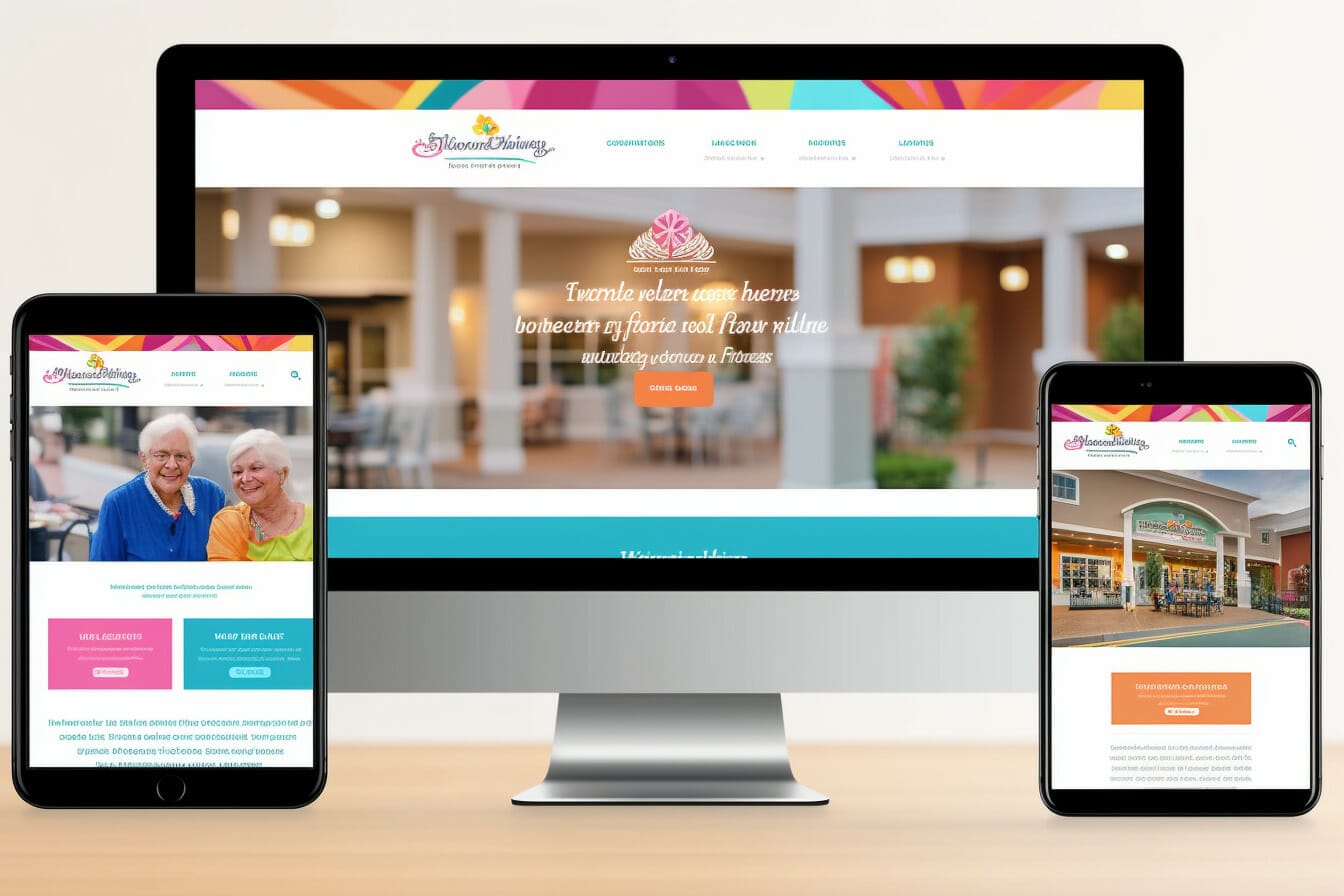Hey there! As a digital marketing manager for assisted living communities, I know how important it is to maintain a professional image online. With the rise of social media and other digital platforms, your community’s reputation can be easily damaged if you’re not careful.
The good news is that with some strategic planning and consistent effort, you can build and maintain a strong online presence that reflects the values and quality of care at your assisted living community. In this article, we’ll discuss some key strategies for using digital marketing to showcase your community in the best light possible. Let’s get started!
Establishing A Brand Identity
As a digital marketing manager for an assisted living community, creating a strong brand identity is crucial to maintaining a professional image online. There are two key elements to consider when establishing your brand: creating a logo and choosing a color scheme.
Your logo should be simple yet memorable, conveying the essence of your community’s values and mission. It should be easily recognizable across all platforms, including social media accounts, websites, and email signatures. Consider hiring a graphic designer or using design software to ensure that your logo is high-quality and meets industry standards.
Choosing a color scheme is another important aspect of building a cohesive brand identity. Colors can evoke emotions in viewers, so it’s essential to choose hues that reflect the atmosphere and personality of your community. For example, blue may represent trustworthiness and professionalism while green symbolizes growth and harmony. By selecting colors carefully and consistently incorporating them into all aspects of your digital marketing strategy, you’ll establish a recognizable visual presence that sets you apart from competitors.
With these branding basics in mind, it’s time to move onto identifying your target audience. By understanding who you’re trying to reach with your messaging and imagery, you can tailor your approach specifically to their needs and preferences.
Identifying Your Target Audience
Did you know that 72% of seniors use the internet on a daily basis? This means that digital marketing is an essential tool for maintaining a professional image of your assisted living community. To effectively market your services, it’s important to identify who your target audience is and what they are looking for in a senior care facility.
- Demographic research: Conducting demographic research allows you to understand the age, gender, income level, and other relevant factors of your potential residents.
- Competitive analysis: Analyzing your competitors’ online presence can help you differentiate yourself from them and create content that addresses their weaknesses.
- Psychographic profiling: Understanding the personality traits, values, interests, and lifestyle habits of your target audience will allow you to tailor your messaging accordingly.
- Persona development: Creating fictional characters that represent different segments of your target audience helps personalize your communications and make them more relatable.
By leveraging these four strategies, you’ll be able to develop a deep understanding of who your ideal resident is and how to appeal to them through digital marketing. In the next section, we’ll discuss how to craft a compelling story that resonates with this audience.
Crafting A Compelling Story
Identifying your target audience is essential in creating a successful digital marketing strategy for your assisted living community. However, simply knowing who you are targeting is not enough to stand out from the competition and maintain a professional image. This is where storytelling comes into play.
Using storytelling for marketing can help create emotional connections with potential residents and their families. By sharing stories of current residents and staff members, showcasing events and activities, or highlighting unique features of the community, you can engage your audience on a deeper level. People want to feel connected to the place they may call home, so it’s important to craft a compelling story that resonates with them.
Visual storytelling through photos and videos can be especially effective in capturing attention and conveying emotions. Showcasing the unique features and amenities of your assisted living community through visual storytelling allows potential residents to envision themselves living there. Highlighting socialization opportunities, dining experiences, wellness programs, and more can make a significant impact on their decision-making process.
Creating emotional connections through storytelling is just one aspect of maintaining a professional image online. In the next section, we will explore how having a responsive website can further enhance your digital marketing efforts by providing an optimal user experience for visitors.
Creating A Responsive Website
I’m excited to talk about creating an engaging website design for our assisted living community. We need to make sure it looks professional and appeals to our target demographic. I also think it’s important to make sure our website is optimized for mobile devices, as more and more people are using their phones to browse the web. By doing these two things, we can create a great digital presence and maintain a professional image for our community.
Creating An Engaging Website Design
As a digital marketing manager for an assisted living community, ensuring that your website is engaging and visually appealing can make all the difference in attracting potential residents. Implementing color psychology in your website design can have a significant impact on how visitors perceive your community. For instance, using warm colors like orange or yellow can evoke feelings of happiness and friendliness while blues and greens convey calmness and security.
In addition to utilizing color psychology, it’s crucial to prioritize user experience when designing your site. Visitors should be able to navigate through your pages with ease and find information quickly. Creating a clear visual hierarchy by implementing headings, subheadings, and bullet points will also help guide users to important information they may be looking for.
Lastly, mobile optimization cannot be overlooked when it comes to creating a responsive website. With more people accessing websites from their smartphones than ever before, it’s essential that your site is optimized for mobile devices. This means having larger buttons for easy navigation, clean layouts without cluttered text or images, and quick loading times. By focusing on these key elements when designing your website, you can maintain a professional image for your assisted living community online.
Optimizing For Mobile Devices
As a digital marketing manager for an assisted living community, creating a responsive website is crucial to attracting potential residents and maintaining a professional online presence. One important aspect of responsive design that cannot be overlooked is mobile optimization. With more people accessing websites from their smartphones than ever before, it’s essential to prioritize mobile first design when developing your site.
Mobile first design means designing your website with the smallest screen in mind so that it looks great on any device. This approach ensures that users have a positive experience regardless of how they access your site. Mobile optimized sites should load quickly, have clear navigation menus, and use easy-to-read fonts and colors. Utilizing features like click-to-call buttons can also make it easier for visitors to get in touch with your team.
User experience optimization is another critical element of mobile-friendly web design. Visitors should be able to navigate through your pages easily, find information quickly, and view images or videos without difficulty. To ensure optimal user experience, consider implementing intuitive navigation menus, large buttons for easy tapping on smaller screens, and minimizing page loading times as much as possible. By prioritizing these aspects of mobile-first design and user experience optimization, you can create a responsive website that effectively showcases all that your assisted living community has to offer.
Utilizing SEO For Greater Visibility
SEO optimization is a critical aspect of digital marketing that can help your assisted living community rank higher in search engine results. Ranking high on Google’s first page means more visibility, which translates to increased website traffic and potential leads. Keyword research is crucial when optimizing your website content for SEO purposes. By identifying the most relevant keywords and incorporating them naturally into your content, you increase the chances of appearing at the top of search results.
One way to ensure effective keyword research is by conducting an analysis of what people are searching for related to your industry. This will give insight into popular topics, common questions, and trends among seniors looking for an assisted living community. Once you have identified these keywords, use them strategically throughout your website to improve its ranking and drive more organic traffic.
Effective SEO optimization requires ongoing efforts as algorithms change frequently; therefore, consistent monitoring and adjustment are necessary to maintain a strong online presence. There are several tools available that can assist with tracking rankings, analyzing data, and providing insights on how to improve your strategy continually.
- Creating engaging blog posts with keyword-rich titles
- Including images or videos to break up text-heavy pages
- Using internal linking within blog posts to keep visitors engaged
By implementing these strategies regularly, you’ll be able to build a robust online presence that appeals to both search engines and potential residents alike.
Building a Strong Social Media Presence
Building A Strong Social Media Presence
Let’s face it, social media is not going anywhere anytime soon. As a digital marketing manager for an assisted living community, building a strong social media presence should be at the forefront of your mind when developing your overall social media strategy. A robust and active online presence can help to increase visibility and engagement with potential residents, their families, and other stakeholders.
One way to build a strong social media presence is by focusing on community engagement. This means creating content that resonates with your audience and encourages them to interact with you. It could be anything from sharing news about upcoming events in your facility or highlighting resident success stories. Remember, the key here is to create content that sparks interest and conversation within the wider community.
To give you some inspiration for engaging social media posts, take a look at this table:
| Emotional Appeal | Example |
|---|---|
| Love | 5 heartwarming stories of our residents finding love |
| Gratitude | Thanking our staff for all they do every day |
| Humor | Funny memes related to life in an assisted living community |
| Inspiration | Inspirational quotes from notable figures who lived fulfilling lives |
As you can see, building a strong social media presence requires intentionality and creativity. By focusing on community engagement through thoughtful content creation, you can attract more followers and keep them engaged over time. In the next section, we’ll dive deeper into how you can create even more engaging content that will capture the attention of your target audience.
Creating Engaging Content
Generating ideas for engaging content is an important part of any content strategy. When it comes to creating engaging content for your assisted living community, it’s essential to focus on topics that will resonate with your target audience. This may include articles or blog posts on senior health and wellness, tips for successful aging, and stories about the vibrant community within your facility.
One effective way to generate ideas is by encouraging residents and staff members to contribute their own experiences and insights. Sharing personal stories can help humanize your brand and establish a deeper connection with potential residents and their families. Additionally, you can leverage popular trends in social media and current events to create timely and relevant content that will capture attention.
Another key aspect of developing an effective content strategy is establishing a consistent publishing schedule. Whether you decide to post new content weekly or bi-weekly, maintaining a steady stream of fresh material will keep your digital presence active and engaged with your audience. By planning ahead and utilizing a variety of formats such as videos, infographics, podcasts along with written pieces, you’ll ensure that there’s always something compelling for visitors to read or watch when they visit your website or social media channels.
To take things up a notch in terms of engagement possibilities with prospects, leveraging email marketing campaigns can be extremely beneficial for assisted living communities looking to reach out directly to potential clients.
Leveraging Email Marketing
Now that we have discussed the importance of creating engaging content for your assisted living community’s digital marketing strategy, let’s shift our focus to leveraging email marketing. Email automation is a powerful tool that can help you maintain a professional image while keeping your audience engaged and informed. One example of effective email automation is using personalized drip campaigns for lead nurturing.
To ensure successful email automation, it’s important to first segment your audience based on their interests and needs. This will allow you to personalize your messaging and increase engagement rates. Within each segmented group, consider implementing a drip campaign with a series of automated emails designed to nurture leads and move them further down the sales funnel.
In addition to segmentation and drip campaigns, there are other ways to effectively leverage email marketing for maintaining a professional image. Consider adding social proof in the form of testimonials or case studies within your emails to build trust with potential clients. You could also use dynamic content to tailor messages based on where users are in the customer journey. By taking these steps towards personalization, you’ll be able to create deeper connections with prospects while maintaining professionalism.
Moving forward, monitoring your online reputation should also be an essential part of your digital marketing strategy as it directly impacts how potential clients view your assisted living community.
Monitoring Your Online Reputation
As a digital marketing manager for assisted living communities, it is essential to monitor your online reputation. This includes responding to reviews and handling negative feedback promptly. Your community’s image can be greatly impacted by how you handle these situations.
When responding to reviews, whether they are positive or negative, always thank the reviewer for taking the time to leave their feedback. For negative reviews, offer a sincere apology and ask if there is anything you can do to make things right. It is important not to argue or get defensive in any way as this will only reflect poorly on your community.
Handling negative feedback is never easy, but it can be an opportunity for growth and improvement. Take each comment seriously and see what changes can be made within your community to address any issues mentioned. Remember that potential residents and their families often look at online reviews before making a decision about where they will live. By showing that you take feedback seriously, you are demonstrating that your community values its residents’ opinions.
Moving forward, measuring your success with analytics is crucial in ensuring that all aspects of your digital marketing efforts align with your overall goals.
Measuring Your Success With Analytics
As a digital marketing manager for assisted living communities, it is crucial to measure the success of your efforts through analyzing data. Just like how doctors use vital signs to monitor their patients’ health, you need analytics to keep track of your community’s online growth and performance. Analyzing data allows you to gauge which strategies are working and where improvements can be made.
To accurately analyze data, you must first set clear goals that align with your overall marketing strategy. These goals should be specific, measurable, attainable, relevant, and time-bound (SMART). Once these goals have been established, use tools such as Google Analytics or social media insights to gather metrics on website traffic, engagement rates, conversion rates, etc. By tracking these key performance indicators (KPIs), you can determine whether your current tactics are effective in achieving your desired outcomes.
After gathering enough data from your KPIs, adjust your strategies accordingly based on what works best for your audience. This involves tweaking headlines and ad copy to improve click-through rates (CTR), testing different calls-to-action (CTA) to increase conversions, experimenting with various social media platforms to see which ones generate the most engagement and leads – all while keeping an eye on the budget allocated towards each tactic. Continuously analyzing data and adjusting strategies will help maintain a professional image of your assisted living community through digital marketing.
- Here are five bullet points that may help you better understand why measuring success with analytics is necessary:
- It helps identify successful campaigns
- Helps optimize future content
- Provides insight into target audiences
- Allows us to make informed decisions based on facts rather than assumptions
- Saves money by avoiding ineffective campaigns – and helps allocate resources towards strategies that have proven to be successful.
Frequently Asked Questions
How Can We Deal With Negative Reviews Or Comments On Social Media?
As a digital marketing manager for assisted living communities, it’s important to know how to handle negative comments and reviews on social media. Responding professionally is key in maintaining the reputation of your community. It’s important to address the issue directly, apologize if necessary, and offer a solution or explanation. However, sometimes there may be trolls who are purposely trying to cause trouble. In these situations, it’s best not to engage with them publicly and instead focus on addressing any legitimate concerns from other commenters. Overall, responding appropriately and professionally can help turn a negative situation into an opportunity to showcase your dedication to resident satisfaction.
Is It Important To Have A Mobile-Friendly Website For Our Assisted Living Community?
As a digital marketing manager for assisted living communities, it is crucial to understand the importance of having a mobile-friendly website. Not only does it improve accessibility for potential residents and their families, but it also impacts user experience by providing easy navigation and quick loading times. The benefits of accessibility and positive user experience cannot be overstated, as they are key factors in attracting and retaining customers. Therefore, investing in a mobile-responsive website should be a top priority for any assisted living community looking to establish itself as professional and reputable in the eyes of its audience.
Should We Consider Paid Advertising On Social Media Platforms?
As a digital marketing manager for assisted living communities, I highly recommend considering paid advertising on social media platforms. By doing so, you can maximize your ROI by targeting a specific audience that is interested in the services and amenities offered by your community. With the ability to set budgets and track performance metrics, paid advertising provides a cost-effective way to reach potential residents and their families. Don’t miss out on this opportunity to elevate your digital marketing strategy and attract more qualified leads.
How Often Should We Update Our Website With New Content?
Updating your website with fresh content is crucial to maintain a strong online presence. According to Hubspot, businesses that publish 16+ blog posts per month receive 3.5 times more traffic than those who only post once a week. As a digital marketing manager for assisted living communities, it’s important to have a solid content strategy in place and incorporate SEO optimization techniques into each piece of new content. This will not only improve search engine rankings but also provide valuable information for potential residents and their families. Keep in mind that updating your website doesn’t always mean creating brand new pages – refreshing existing ones can be just as effective!
What Metrics Should We Track To Measure The Success Of Our Digital Marketing Efforts?
As a digital marketing manager for assisted living communities, it is important to track the success of our efforts through metrics such as conversion rates and engagement levels. Conversion rates measure how many website visitors turned into leads or customers, while engagement levels show how much interaction we receive on social media platforms. By monitoring these metrics, we can see what strategies are working and adjust accordingly to improve overall success. It’s crucial to stay up-to-date on analytics in order to maintain a competitive edge and effectively reach potential residents.
Conclusion
As a digital marketing manager for assisted living communities, it is crucial to maintain a professional image online. This can be achieved by addressing negative reviews or comments on social media promptly and professionally. By acknowledging these concerns and offering solutions, you can showcase your commitment to customer satisfaction.
Furthermore, having a mobile-friendly website is paramount in today’s digital landscape. A responsive site ensures that potential residents and their families can access information about your community easily from any device. Additionally, consider utilizing paid advertising on social media platforms to increase visibility and reach new audiences. Finally, regularly updating your website with fresh content helps establish credibility and builds trust among visitors. By monitoring metrics such as traffic and engagement rates, you can measure the success of your efforts and make necessary adjustments for continued growth.
In conclusion, maintaining a strong digital presence requires vigilance and attention to detail. As an assisted living community, it is essential to provide exceptional care while also showcasing professionalism through various online channels. By implementing best practices in digital marketing, we can create lasting impressions that resonate with our target audience and set us apart from the competition.






